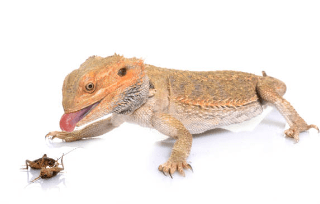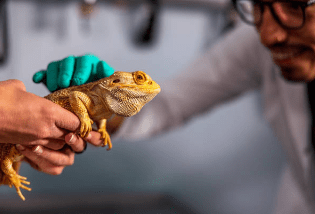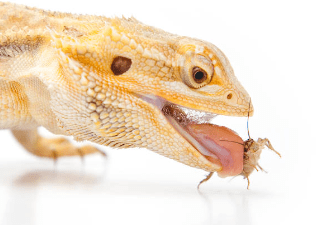Ever wondered what’s up with your bearded dragon’s tongue? Don’t worry, you’re not alone.
As a herpetology enthusiast with a focus on reptiles, I know how intriguing these creatures can be.
Let’s be honest, you’ve probably found yourself lost in thought watching your bearded dragon flick its tongue around like it’s tasting the air.
Spoiler alert: it kind of is.
The tongue of a bearded dragon isn’t just for show; it’s a multifunctional marvel.
That’s right, their tongues serve a multitude of purposes, from hunting to social interactions.
So, fasten your seatbelts, and let’s embark on a fascinating journey, exploring every nook and cranny of the bearded dragon tongue.
Before you start picturing your pet lizard as a superhero, let’s dive in.
We’ll cover everything from anatomy to function, and even what that little tongue tip might be telling you.
Table of Contents
Anatomy of the Bearded Dragon Tongue
Okay, let’s get into the nitty-gritty. Anatomy is key in understanding what makes this tongue so unique. So, what exactly are we looking at when we stare into the gaping mouths of our bearded buddies?
Length and Width
The length and width of a bearded dragon’s tongue are often directly correlated with the size and age of the dragon. The tongue usually stretches about the length of the creature’s head, allowing it to easily reach out for food or to explore its environment.
When you observe closely, the bearded dragon’s tongue tip gives an indication of its reach, especially in capturing prey.
Texture and Coloration
Now, on to the visual appeal. The bearded dragon’s tongue has a slightly rough texture designed to grip onto its prey. And what about the colors you ask? Well, that brings us to a palette of possibilities.
Common Colors of the Tongue
From blush pink to subtle gray, the bearded dragon tongue comes in an assortment of shades. Each hue tells a tale about the dragon’s overall health and emotional state. So yes, it’s not just for show; it’s a mood ring of sorts!
White Tip on Bearded Dragon’s Tongue
Ever spotted a bearded dragon’s white tongue? Before you start worrying, know that this is usually not an alarming symptom. The white coloring, particularly at the tongue tip, is often just a variation in pigmentation and is mostly harmless.
However, if the white persists, it could indicate dehydration or other health problems. So, it’s important to monitor any sustained bearded dragon’s white tongue instances.
Black Tip on Bearded Dragon’s Tongue
If you spot a black tip, it’s time to consult a vet. Unlike the benign white tip, a black tip often indicates a serious health issue like rot or infection. Immediate veterinary attention is vital if you notice a black bearded dragon tongue tip.
Muscles and Skeletal System
Flexibility, anyone? The tongue owes its versatile movement to a set of specialized muscles and skeletal structures. This anatomical setup allows for quick extensions and retractions, making the bearded dragon a formidable hunter. It’s like having a built-in harpoon!
Presence of Papillae or Taste Buds
Last but not least, let’s talk about taste. While they may not enjoy a five-course gourmet meal, bearded dragons do have some taste buds, or papillae. These little sensory nodes give them a basic understanding of their food’s flavor, helping them discern between the tasty and the taboo.
Functionality of the Bearded Dragon Tongue
Alright, moving on to what this organ does in everyday dragon life. It’s not just for sticking out when they’re feeling cheeky, you know.
Hunting and Feeding Behavior
First up, the bearded dragon tongue tip is the MVP when it comes to hunting. It’s fast, it’s sticky, and it gets the job done. Picture a chameleon’s tongue but scaled-down and less dramatic.
Types of Prey They Target
Ah, the menu! Bearded dragons are opportunistic eaters. Their tongue is perfectly designed to snag insects like crickets, mealworms, and even the occasional small mammal. Basically, if it fits in their mouth and it moves, it’s dinner.

Sensory Abilities and Taste Perception
Here’s the part that’ll tickle your taste buds. While not as sophisticated as a human palate, the bearded dragon’s tongue still has some sensory capabilities. Think of it as their way of sampling the world, determining what’s edible and what’s not.
Drinking and Hydration
No, your bearded dragon isn’t sipping a mojito by the pool, but its tongue does help it stay hydrated. When they come across a water source, they’ll extend their tongue to lap up what they can. Simple, yet effective.
Communication and Social Interactions
Believe it or not, tongue-flicking can be a form of dragon small talk. Quick flicks could mean curiosity or a friendly “how do you do?” to another dragon. It’s like their version of a handshake, just a lot more hygienic.
Temperature Regulation
Feeling hot, hot, hot? Your bearded dragon is no stranger to overheating. The tongue plays a role here, too. By sticking it out and even panting a little, they can regulate their body temperature to some extent.
Cleaning and Grooming
Personal hygiene matters, even in the animal kingdom. The bearded dragon’s tongue helps in cleaning its face and even some parts of its body. Yes, a tongue bath. Cute, but not something we’d recommend trying at home!
Interaction with the Environment
How does a bearded dragon know its world? A flick of the tongue can tell them a lot. From the taste of the soil to the scent in the air, it’s their way of understanding their habitat.
Health Indicators
Last but not least, the tongue can serve as a health barometer. A change in its appearance or behavior may be the first sign of an underlying health issue. A listless or discolored tongue could be a signal for a vet visit. So, it pays to pay attention to that little pink, gray, or white tip.
Common Issues Related to Bearded Dragon Tongue
As amazing as these tongues are, they’re not immune to problems. Let’s delve into some of the common issues you might encounter.
Tongue Injuries
Ouch, right? While hunting or exploring, bearded dragons can accidentally bite their tongue or scrape them on rough surfaces. If you notice symptoms like bleeding, excessive drooling, or an unusually withdrawn tongue, it’s time for a vet check-up.
Tongue injuries need prompt attention to avoid infection or further harm.
Tongue Retention Issues
Imagine having a fantastic tool but being unable to retract it back into your toolbox. Some bearded dragons face this issue, where their tongue doesn’t properly retract. Causes could range from neurological problems to physical obstructions. Either way, it’s a situation warranting immediate medical attention.
Difficulty in Eating or Hunting
Does your dragon seem unenthusiastic during mealtime? A struggling tongue could be the culprit. Difficulties in eating or hunting often link back to muscular issues, previous injuries, or even malnutrition.
If your pet’s eating habits suddenly change, a vet’s opinion will be invaluable in determining the root cause.

Tongue Flicking Abnormalities
If you’ve got a keen eye, you’ll notice the rhythm and frequency of your bearded dragon’s tongue flicking. Deviations from their normal flicking could indicate stress, illness, or even neurological issues. So, whether it’s frenzied flicking or a complete lack of tongue activity, any abnormal behavior deserves a closer look.
Tongue Infections or Lesions
Last but definitely not least are infections and lesions—every bearded dragon owner’s nightmare. Symptoms can include a swollen or discolored tongue, along with a foul odor. Infections often require antibiotic treatment, and in some cases, surgical intervention.
Time is of the essence, as untreated infections can spread, affecting your pet’s overall health.
Conclusion
Phew, that was a mouthful—literally! The bearded dragon’s tongue is an intricate organ, bustling with functionality and anatomical wonders. So the next time your bearded dragon sticks out its tongue, you’ll know it’s doing more than just being cute. It’s a window into its well-being and a tool for living its best dragon life.
FAQs
Can My Bearded Dragon Lick Me?
Yes, bearded dragons can and sometimes do lick their owners. This behavior is usually a form of exploration and sensory perception, rather than affection.
Is a Blue Tongue Normal for My Bearded Dragon?
A blue tongue is not normal for a bearded dragon and could indicate a serious health concern like a lack of oxygen. Immediate veterinary attention is strongly recommended.
Why Does My Bearded Dragon Stick Its Tongue Out Constantly?
If your bearded dragon is sticking its tongue out frequently or for extended periods, it could be trying to regulate its temperature or might be experiencing respiratory issues. A vet consultation is advised for a thorough diagnosis.
Alina Hartley is a small-town girl with a ginormous love of bearded dragons. It all started with Winchester, a baby bearded who was abandoned at the shelter by his former owners because of a birth defect that caused one front leg to be shorter than the other. Alina originally went to the shelter looking for a guinea pig, but one look at Winchester and it was love at first sight. From that day on, Alina has dedicated her life to learning everything she can about bearded dragons. She loves helping new beardie parents start their incredible journey with these magnificent reptiles.
Follow her on:
LINKEDIN
TWITTER.
Read her latest articles HERE
Learn more about her HERE.

